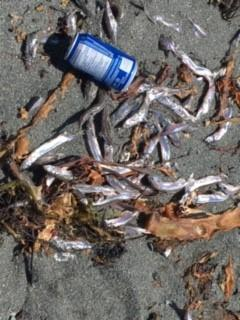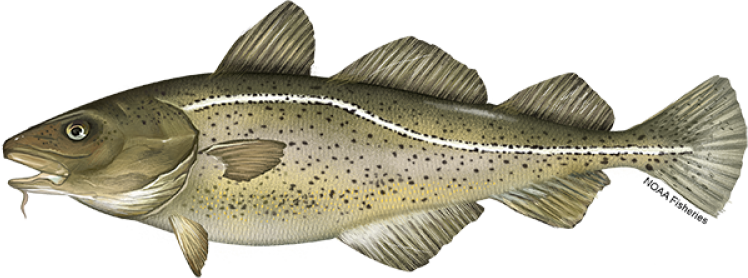Search
Fish
We cannot possibly name all the fish in the sea, but a few species are more likely to be encountered in the waters, and on the menu!
Atlantic Cod
When Newfoundlanders refer to fish they mean Cod. Indeed, as our brief history of settlement in Trepassey and Renews demonstrates, for centuries the cod fishery was the most important economic resource sustaining the outports (settlements previously only accessible by boat) throughout the island.
The closure of the Atlantic Cod fishery by the Federal Government in 1992 had a devastating impact on this area and the whole of Newfoundland. Trepassey with its major fish plant was particularly hard hit with the closure. The Cod in fish and chips most likely comes from northern Newfoundland, though some is caught local during the restricted ‘family fishery’ season.
Capelin
Capelin is the key bait fish for the marine food chain and especially for all nesting seabirds along this coast. Capelin gather in huge schools offshore in summer. Most “roll” (as in, roll in on the breaking waves) to spawn on the sandy sections of pebble beaches at Portugal Cove South, Trepassey and along the huge beach in Holyrood Bay that stretches for kilometres from Peter’s River to St. Vincent’s. In recent years Capelin numbers have been low, a fraction of historic figures. In good Capelin years major seabird and whale action can be expected all along the coasts. Unfortunately Capelin are being commercially harvested for export (Capelin roe is particularly desirable in Asian markets). If Capelin stocks are allowed to recover to more historic levels, the whale and seabird action will become an even greater tourist attraction throughout the summer.
 Dead Capelin on Trepassey Beach after a spawning run; note can for size comparison
Dead Capelin on Trepassey Beach after a spawning run; note can for size comparison
The Southeast Avalon is known for salmon and trout fishing. During the season, fishermen can be seen up to the top of their hip waders in Biscay Bay River and lower Northwest Brook (Trepassey). Fishermen are primarily seeking Atlantic Salmon and sea-run Brown and Brook Trout. Non-residents require licences (available at Pennell’s Garage on Route 10, northwest Trepassey) to fish for trout and a special licence for salmon. Fly fishing is mandatory on selected parts of scheduled rivers.
Leatherback Turtles
While it is hard to look for fish and other marine species in the ocean, our area sometimes comes up with some surprises. Included in this is the rare occurrence of Leatherback Turtles which lay eggs in the Caribbean and come north in summer seeking out jellyfish, their prime food. While these turtles normally only reach Nova Scotian waters recently they have been spotted in southeastern Newfoundland waters. It is possible that warmer water temperatures along our south coast are responsible.
Bluefin Tuna
Bluefin tuna are found in Newfoundland waters and are the subject of both commercial and recreational fishing. The commercial fishery is managed under the International Commission for the Conservation of Atlantic Tunas (ICCAT). The fishery is open year-round but the main directed fishery is usually in late July to late November.
Bluefin tuna populations are increasing in Newfoundland waters, likely due to a changing environment and warmer waters. They feed largely on pelagic fish such as herring, mackerel and capelin. Due to the regular occurrence of capelin in our waters and warming water temperatures the sighting o Bluefin Tuna has become a more frequent event along the south coast sites where capelin shoals congregate.
Small schools of Bluefin Tuna occasionally can be observed off beaches and especially off headlands such as Powle’s Head as they mill about the water after their prey. Their movements are quick so usually you would not get as as good a view as the image above captured by Clifford Doran.
Ocean Sunfish
In recent years Ocean Sunfish, more often associated with much warmer waters, have shown up to be photographed locally. Their primary food is jellyfish which are more frequently encountered in local waters.
